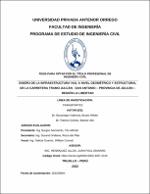Diseño de la infraestructura vial a nivel geométrico y estructural de la carretera tramo Julcán - San Antonio - Provincia de Julcán - Región La Libertad

View/
Download
(application/pdf: 135.6Kb)
(application/pdf: 135.6Kb)
Date
2022Author(s)
Bocanegra Valencia, Bryam Wilder
Patricio Gómez, Banner Alin
Metadata
Show full item recordAbstract
La presente investigación se desarrolla en la Carretera que une el Distrito de
Julcán con el Centro Poblado de San Antonio, en la Provincia de Julcán, Región La
Libertad, en la cual se realiza una investigación de tipo aplicada, cuyo objetivo es
llevar a cabo un diseño geométrico y estructural con los parámetros reales de la
zona.
En la presente investigación se realiza un análisis real del tráfico, los cuales
se usaron para determinar el Número de Ejes Equivalentes (EE), luego se realiza
un Estudio de Mecánica de Suelos con fines de pavimentación, teniendo como guía
la normativa vigente, Manual de Ensayo de Materiales del Ministerio de Transportes
y Comunicaciones, al igual el Diseño Geométrico del tramo vial, utilizando la
normativa vigente, Manual de Carreteras DG-2018. Además de realizar el
levantamiento Topográfico de todo el tramo en estudio.
Se concretó el diseño de la Estructura del Pavimento Flexible tomando como
como guía metodológica AASHTO 93, tomando los parámetros antes mencionados.
En la investigación se determinó una carretera de Segunda Clase, en un
terreno accidentado (tipo 3), con una longitud total de 12.569 Km, presentando una
calzada que contiene dos carriles de 3.30 m de ancho cada una, con un bombeo de
2.50%, además de implementar un sistema de evacuación de aguas pluviales. En
cuanto al diseño estructural del Pavimento flexible, de preferencia asfalto en
caliente, está conformado por una capa de 9 cm de carpeta asfáltica, 20 cm de una
base granular y 10 cm de subbase granular.
Con lo realizado en esta investigación queremos presentar la mejora para la
transitabilidad de la vía y hacer llegar este conocimiento a futuros proyectos de
modelo parecido. The present investigation is carried out on the highway that connects the
District of Julcan with the Populated Center of San Antonio, in the Province of Julcan,
La Libertad Region, in which an applied type of investigation is carried out, whose
objective is to carry out a geometric and structural design with the real parameters
of the area.
In the present investigation, a real traffic analysis is carried out, which were
used to determine the Number of Equivalent Axles (EE), then a Soil Mechanics
Study is carried out for paving purposes, taking as a guide the current regulations,
Manual of Material Testing of the Ministry of Transport and Communications, as well
as the Geometric Design of the road section, using current regulations, Highway
Manual DG-2018. In addition to carrying out the Topographic survey of the entire
section under study.
The design of the Flexible Pavement Structure was specified taking AASHTO
93 as a methodological guide, taking the aforementioned parameters.
In the investigation, a Second-Class Road was determined, in a rough terrain
(type 3), with a total length of 12.569 km, presenting a road that contains two lanes
of 3.30 m wide each, with a pumping of 2.50%, in addition to implementing a
rainwater evacuation system. Regarding the structural design of the flexible
pavement, preferably hot asphalt, it is made up of a 9 cm layer of asphalt layer, 20
cm of a granular base and 10 cm of granular sub-base.
WitThe present investigation is carried out on the highway that connects the
District of Julcan with the Populated Center of San Antonio, in the Province of Julcan,
La Libertad Region, in which an applied type of investigation is carried out, whose
objective is to carry out a geometric and structural design with the real parameters
of the area.
In the present investigation, a real traffic analysis is carried out, which were
used to determine the Number of Equivalent Axles (EE), then a Soil Mechanics
Study is carried out for paving purposes, taking as a guide the current regulations,
Manual of Material Testing of the Ministry of Transport and Communications, as well
as the Geometric Design of the road section, using current regulations, Highway
Manual DG-2018. In addition to carrying out the Topographic survey of the entire
section under study.
The design of the Flexible Pavement Structure was specified taking AASHTO
93 as a methodological guide, taking the aforementioned parameters.
In the investigation, a Second-Class Road was determined, in a rough terrain
(type 3), with a total length of 12.569 km, presenting a road that contains two lanes
of 3.30 m wide each, with a pumping of 2.50%, in addition to implementing a
rainwater evacuation system. Regarding the structural design of the flexible
pavement, preferably hot asphalt, it is made up of a 9 cm layer of asphalt layer, 20
cm of a granular base and 10 cm of granular sub-base.
With what has been done in this research, we want to present the
improvement for the passability of the road and bring this knowledge to future
projects of a similar model.
Collections
- Ingeniería Civil [1260]

